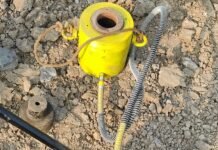The hazards are similar to those of the power presses. Some particular hazardous are sudden dropping of the slide due to power failure of the breaking of a pressure line, defective dual controls, leaking valves, air pressure built up between dual controls.
Contents
Control measures are:
- Limiting slide travel by means of a cylinder designed for short travel by die or jib and fixture design or by auxiliary stops.
- Fixed barrier guards.
- Movable barrier guards.
- Electrically controlled and air-operated solenoid valve holds the slide in an up position in case of power failure.
- Interlock guard to stop closing movement of the tools.
- In the case of Die-Casting Presses to avoided trapping and splashes by molten metal, a sliding cover is interlocked with hydraulic or pneumatic power. A mechanical scotching device to restrain the platens from closing when the interlock sliding shield is open and guard operated electrical switches linked to the solenoid of the main platen cylinder control valve are also necessary.
- Plastic Moulding Presses are of two types-injection and compression. In the case of the injection molding press, a sliding cover on vertical parting (dies) surfaces and in case of compression type an interlocked scotch (a heavy struck or a hook type) is necessary to avoid trapping between dies.
- Rubber Moulding Press is compression molding type and an interlocked guard is necessary to prevent trapping.
- Bailing press needs a hinged guard interlocked with the driving power.
- Pie and Tart press used for molding and filling pastry for pies and tarts, a hinged guard for protection against operating ram, electro-mechanical brakes on motor and blanking of gaps near tops of the molds are necessary.
- Brick and Tile pressure need interlock guards or photoelectric safety device. In the case of mechanically fed presses, a tunnel guard near the delivery opening is necessary.
Press Brakes
A press brake is a type of power press used to cold-form angles, channels and curved shapes in the plate, strip or sheet metal stock. It is also used for punching, embossing, corrugating, notching and other operation.
Typical hazards are:
- Crushing between the punch and the die or between the work being bent and the ram.
- Cut from contact with stock being processed.
- Injuries from handling punching and dies.
Control devices are
- A front horizontal work-rest cum distance guard (this may be a fixed, automatic or interlocked guard) adjusted to coincide with the height of die and supporting brackets anti fall back device on the rear side to stop the material being fallen.
- The photoelectric device in addition to fixed, interlock or automatic guards.
- Worn punches and dies should be retooled or discarded as they give excessive strain on the press.
- Instruction and training of operators.
- Periodic inspection and well maintenance of parts in good working condition.
- Starting devices such as a two-hand switch or levers, treadle bars, footswitches. Foot controls should be covered by stirrup guards to prevent accidental tripping.
- Reverse control with the start switch to use when tools become frozen.
- Soft metal pliers, rather than fingers, should be used to feed small parts to the press. Fingers should not be brought within 10 cm of the point of operation.
- Positive over-run stop device, single stroke device and elimination of treadles by a shrouded pedal to prevent inadvertent operation.
- Operators should be instructed to test operate the machine before the start of each shift. They should be well trained and well informed of the work.






